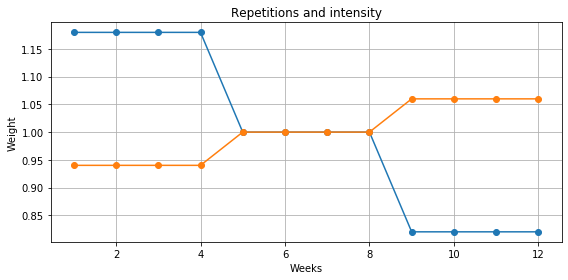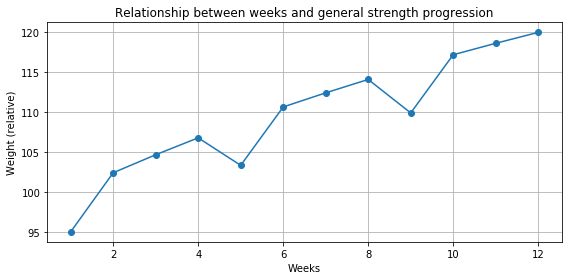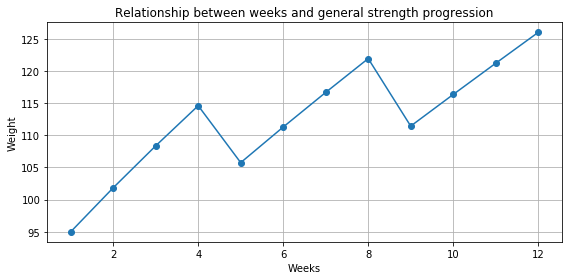Example - Block periodization¶
This notebook shows features of streprogen, the Python strength program generator.
Contributions to the code are welcome. :)
[1]:
!pip install streprogen matplotlib --quiet
Imports¶
[2]:
from streprogen import (Program,
reps_to_intensity,
progression_diffeq,
progression_sawtooth,
progression_sinusoidal)
import matplotlib.pyplot as plt
import functools
[3]:
duration = 12
Set up periodization of intensity and repetitions¶
You can periodize intensity and repetitions by using progression_sawtooth or progression_sinusoidal or creating custom functions.
Below I show how to create custom functions.
[4]:
def rep_scaler_func(week:int):
"""Custom factors that are multiplied with the `reps_per_exercise`."""
index = week - 1
factors = [1.18] * 4 + [1.0] * 4 + [0.82] * 4
return factors[index % len(factors)]
def intensity_scaler_func(week:int):
"""Custom factors that are multiplied with the `intensity`."""
index = week - 1
factors = [0.94] * 4 + [1.0] * 4 + [1.06] * 4
return factors[index % len(factors)]
[5]:
plt.figure(figsize=(8, 4))
plt.title("Repetitions and intensity")
weeks = list(range(1, duration + 1))
y = [rep_scaler_func(w) for w in weeks]
plt.plot(weeks, y, '-o', label="Rep scalers (factors)")
y = [intensity_scaler_func(w) for w in weeks]
plt.plot(weeks, y, '-o', label="Intensity scalers (factors)")
plt.xlabel("Weeks"); plt.ylabel("Weight"); plt.grid(); plt.tight_layout()

Optional: Set up periodization of strength progression (weight lifted)¶
You can periodize progression by using progression_sawtooth or progression_sinusoidal or creating your own custom function. Below I show how to create a custom function.
[6]:
def progression_func(week, *args, **kwargs):
weight = progression_diffeq(week, *args, **kwargs, k=1)
# Multiply every 4th week by 0.95 for a deload week
if (week - 1) % 4 == 0:
return weight * 0.95
else:
return weight
[7]:
plt.figure(figsize=(8, 4))
plt.title("Relationship between weeks and general strength progression")
weeks = list(range(1, duration + 1))
y = [progression_func(w, start_weight=100, final_weight=120, start_week=1, final_week=12) for w in weeks]
plt.plot(weeks, y, '-o')
# Set up the plot and show it
plt.xlabel("Weeks"); plt.ylabel("Weight (relative)")
plt.grid(); plt.tight_layout()

While it’s possible to create any progression function, using tweaking defaults is often wise, e.g.,:
[8]:
plt.figure(figsize=(8, 4))
plt.title("Relationship between weeks and general strength progression")
weeks = list(range(1, duration + 1))
# Using the `progression_sawtooth` function, we can create out own progression
# function by specifying:
# - k: the non-linearity
# - period: the length of the period (in weeks)
# - scale: the amplitude of the sawtooth
progression_func = functools.partial(progression_sawtooth, k=2.0, period=4, scale=0.05)
y = [progression_func(w, start_weight=100, final_weight=120, start_week=1, final_week=12) for w in weeks]
plt.plot(weeks, y, '-o')
# Set up the plot and show it
plt.xlabel("Weeks"); plt.ylabel("Weight")
plt.grid(); plt.tight_layout()

Program setup¶
Below is the code creating the program.
The functions rep_scaler_func, intensity_scaler_func and progression_func are created in the code above.
[9]:
program = Program(
name='BlockPeriodization',
duration=duration,
reps_per_exercise=20, # Baseline reps per exercise, multiplied by `rep_scaler_func(week)`
min_reps=1,
max_reps=8,
percent_inc_per_week=1,
intensity=84, # Baseline intensity, multiplied by `intensity_scaler_func(week)`
rep_scaler_func=rep_scaler_func,
intensity_scaler_func=intensity_scaler_func,
units='',
# Comment out the line below to use the default progression
progression_func=progression_func,
round_to=2.5,
)
# Here we only use a single day and exercise to show the periodization
# A realistic program would of course include more exercises :)
with program.Day("A"):
program.DynamicExercise(name="Squat", start_weight=100)
Render the program¶
[10]:
# Do the computations and render a program. Might take a few seconds.
program.render()
Print and save the program¶
[11]:
print(program)
----------------------------------------------------------------
Program: BlockPeriodization
Program parameters
duration: 12
reps_per_exercise: 20
intensity: 84
units:
----------------------------------------------------------------
Exercise information
A
Squat 100 -> 112
reps: [1, 8] weekly inc.: 1.0%
----------------------------------------------------------------
Program
Week 1
A
Squat 7 x 75 7 x 75 6 x 77.5 5 x 80
Week 2
A
Squat 7 x 77.5 7 x 77.5 6 x 82.5 5 x 85
Week 3
A
Squat 7 x 82.5 7 x 82.5 6 x 85 5 x 90
Week 4
A
Squat 7 x 87.5 7 x 87.5 6 x 90 5 x 92.5
Week 5
A
Squat 6 x 82.5 5 x 85 5 x 85 4 x 87.5
Week 6
A
Squat 6 x 85 5 x 90 5 x 90 4 x 92.5
Week 7
A
Squat 6 x 90 5 x 92.5 5 x 92.5 4 x 97.5
Week 8
A
Squat 6 x 92.5 5 x 97.5 5 x 97.5 4 x 100
Week 9
A
Squat 4 x 92.5 4 x 92.5 3 x 95 3 x 95 2 x 97.5
Week 10
A
Squat 4 x 95 4 x 95 3 x 100 3 x 100 2 x 102.5
Week 11
A
Squat 4 x 100 4 x 100 3 x 102.5 3 x 102.5 2 x 107.5
Week 12
A
Squat 4 x 102.5 4 x 102.5 3 x 107.5 3 x 107.5 2 x 110
----------------------------------------------------------------
Export the program as .html or .tex, then to .pdf¶
A .html file can be printed directly from your browser, or printed to a .pdf from your browser.
[12]:
# Save the program as a HTML file
with open(f'{program.name}.html', 'w', encoding='utf-8') as file:
# Control table width (number of sets) by passing the 'table_width' argument
file.write(program.to_html(table_width=8))
[13]:
# Save the program as a TEX file
with open(f'{program.name}.tex', 'w', encoding='utf-8') as file:
file.write(program.to_tex(table_width=8))
Use a .tex to generate .pdf if you have LaTeX installed, or use:
- latexbase.com from your browser.
[14]:
# If you have LaTeX installed on your system, you can render a program to .tex
# Alternatively, you can paste the LaTeX into: https://latexbase.com/
# Remove the comment below to print the .tex file
# print(program.to_tex(table_width=8))
